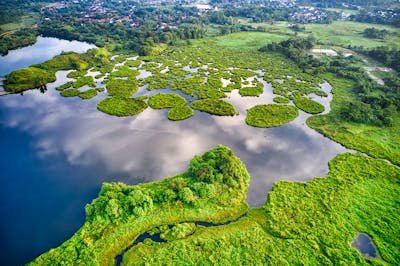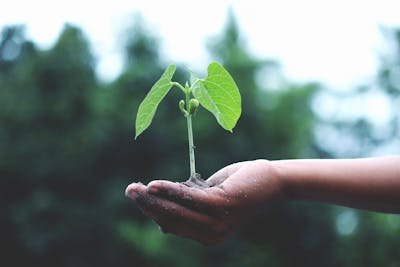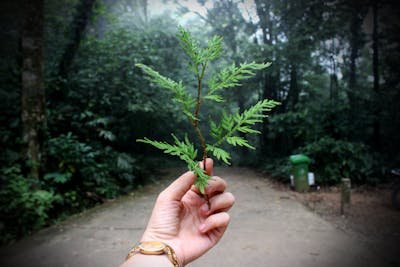The Role of Wetlands in Carbon Sequestration: Nature’s Carbon Storage Powerhouses
Wetlands are one of the most critical ecosystems on the planet, often described as “nature’s kidneys” because of their role in filtering water and providing habitat for wildlife. However, an equally important function of wetlands that is gaining more attention is their ability to sequester carbon. In the fight against climate change, wetlands play a pivotal role in absorbing and storing carbon dioxide (CO2), a major greenhouse gas responsible for global warming. This article will explore what carbon sequestration is, how wetlands contribute to this process, and why preserving these ecosystems is vital for combating climate change.
What is Carbon Sequestration?
Carbon sequestration is the process by which carbon dioxide is captured from the atmosphere and stored in natural reservoirs, such as forests, soils, and oceans. This process helps mitigate the effects of climate change by reducing the amount of CO2 in the atmosphere. There are two main types of carbon sequestration: biological and geological.
Biological carbon sequestration involves plants and soils capturing CO2 through photosynthesis, a process in which plants absorb carbon dioxide and use it to grow. The carbon is then stored in plant biomass, like trunks, roots, and leaves, or in the soil. Wetlands are particularly effective at biological carbon sequestration because of their unique ability to store large amounts of carbon in both plant material and the wet, oxygen-poor soils that prevent carbon from breaking down and returning to the atmosphere.
Wetlands as Carbon Sinks
Wetlands are often referred to as “carbon sinks” because they absorb more carbon than they release. In fact, wetlands store carbon at a much higher rate per unit area than other ecosystems, such as forests or grasslands. Wetlands like marshes, mangroves, and peatlands are highly efficient at trapping carbon in both their vegetation and soil.
The key to wetlands’ effectiveness in carbon sequestration lies in their waterlogged soils. These saturated soils create an anaerobic (oxygen-poor) environment, which slows down the decomposition of organic material. When plants die, their carbon-rich biomass does not decompose as quickly as it would in drier ecosystems. As a result, the carbon remains trapped in the soil for centuries or even millennia.
Peatlands, for example, are one of the most effective types of wetlands for carbon storage. Peat is formed from partially decayed plant material, and over thousands of years, peatlands accumulate thick layers of carbon-rich peat. These ecosystems cover only about 3% of the Earth’s land surface but store twice as much carbon as all of the world’s forests combined.
Types of Wetlands and Their Role in Carbon Sequestration
Different types of wetlands contribute to carbon sequestration in various ways. Below are some of the most important wetland types and their roles in storing carbon.
1. Peatlands
Peatlands are wetlands that are characterized by the accumulation of peat, a dense, carbon-rich material formed from the partial decomposition of plant matter. These ecosystems are found in cooler, waterlogged environments, where organic material decomposes slowly due to the lack of oxygen. Peatlands store vast amounts of carbon, with estimates suggesting that they hold between 500 to 600 billion tons of carbon globally. This makes them one of the most important carbon sinks on the planet. However, when peatlands are drained for agriculture or development, the stored carbon is released as CO2, contributing to climate change.
2. Mangroves
Mangroves are coastal wetlands found in tropical and subtropical regions. These unique ecosystems are composed of salt-tolerant trees and shrubs that grow along coastlines, providing essential habitats for fish and other wildlife. Mangroves are particularly effective at sequestering carbon because they store it both above ground in their trunks and roots, as well as below ground in the rich, organic soils. Mangrove ecosystems can store up to five times more carbon per hectare than tropical rainforests. The destruction of mangroves for coastal development, however, can release significant amounts of carbon back into the atmosphere.
3. Salt Marshes
Salt marshes are coastal wetlands found in temperate regions. These ecosystems are dominated by salt-tolerant grasses and are often found along estuaries and tidal flats. Salt marshes play a significant role in carbon sequestration because they accumulate large amounts of organic material in their soils. Similar to mangroves, the anaerobic conditions in salt marsh soils slow down the decomposition process, allowing carbon to be stored for long periods. Salt marshes also provide essential buffers against coastal erosion and storm surges, further enhancing their ecological value.
4. Freshwater Marshes and Swamps
Freshwater marshes and swamps are wetlands found inland, away from coastal regions. These ecosystems are dominated by plants like reeds, grasses, and trees, which absorb carbon dioxide from the atmosphere through photosynthesis. The waterlogged soils in freshwater wetlands slow down the decomposition of plant material, allowing carbon to be stored in the soil for long periods. These ecosystems can store significant amounts of carbon, especially in their soils, making them important players in the carbon cycle.
The Threats to Wetlands and Their Carbon Sequestration Ability
Despite their critical role in carbon sequestration, wetlands are under threat from human activities such as agriculture, urban development, and resource extraction. These activities often involve draining wetlands, which leads to the release of stored carbon into the atmosphere as CO2, exacerbating climate change.
1. Agriculture and Land Drainage
Wetlands are often drained to create arable land for farming. When this happens, the water that once protected the stored carbon from decomposition is removed, exposing the soil to oxygen. This accelerates the breakdown of organic material, releasing carbon dioxide into the atmosphere. Draining peatlands for agriculture is particularly harmful, as it can result in the release of large amounts of carbon that have been stored for thousands of years.
2. Urban Development
Urban development and infrastructure projects, such as roads and buildings, often encroach on wetland areas. The destruction of wetlands for development not only releases stored carbon but also eliminates the wetlands’ ability to sequester more carbon in the future. Coastal wetlands like mangroves and salt marshes are particularly vulnerable to urbanization, as they are often located in desirable areas for human habitation.
3. Climate Change
Ironically, climate change itself poses a threat to wetlands. Rising temperatures and changing precipitation patterns can alter the hydrology of wetlands, leading to drier conditions. When wetlands dry out, the carbon stored in their soils is more likely to decompose and be released as CO2. Additionally, rising sea levels caused by climate change can submerge coastal wetlands, potentially converting them from carbon sinks into carbon sources.
The Importance of Wetland Conservation
Given the significant role that wetlands play in carbon sequestration, their conservation is essential for mitigating climate change. Protecting and restoring wetlands can help ensure that these ecosystems continue to store carbon and provide other vital ecosystem services, such as water purification, flood control, and habitat for wildlife.
1. Restoration Projects
Wetland restoration projects involve returning degraded wetlands to their natural state. This can include re-wetting drained peatlands, replanting mangroves, and restoring the hydrology of freshwater marshes. These efforts not only restore the wetlands’ ability to sequester carbon but also improve biodiversity and provide other ecological benefits.
2. Policy and Legislation
Governments and international organizations play a crucial role in protecting wetlands through policies and legislation. Initiatives such as the Ramsar Convention on Wetlands, an international treaty for the conservation and sustainable use of wetlands, help raise awareness and encourage the protection of these critical ecosystems.
3. Sustainable Land Use
Sustainable land use practices, such as limiting the expansion of agriculture into wetland areas and promoting the use of buffer zones around wetlands, can help reduce the pressure on these ecosystems. By adopting practices that minimize the impact on wetlands, we can ensure that they continue to function as carbon sinks.
Conclusion: Wetlands as Allies in the Fight Against Climate Change
Wetlands are among the most effective ecosystems for carbon sequestration, playing a vital role in mitigating climate change. However, human activities and climate change threaten their ability to store carbon. Protecting and restoring wetlands is essential for ensuring that they continue to sequester carbon and provide other ecosystem services. By understanding the importance of wetlands and taking action to preserve them, we can harness their potential to combat climate change and protect the planet for future generations.
Wetlands are one of the most critical ecosystems on the planet, often described as “nature’s kidneys” because of their role in filtering water and providing habitat for wildlife. However, an equally important function of wetlands that is gaining more attention is their ability to sequester carbon. In the fight against climate change, wetlands play a pivotal role in absorbing and storing carbon dioxide (CO2), a major greenhouse gas responsible for global warming. This article will explore what carbon sequestration is, how wetlands contribute to this process, and why preserving these ecosystems is vital for combating climate change.
What is Carbon Sequestration?
Carbon sequestration is the process by which carbon dioxide is captured from the atmosphere and stored in natural reservoirs, such as forests, soils, and oceans. This process helps mitigate the effects of climate change by reducing the amount of CO2 in the atmosphere. There are two main types of carbon sequestration: biological and geological.
Biological carbon sequestration involves plants and soils capturing CO2 through photosynthesis, a process in which plants absorb carbon dioxide and use it to grow. The carbon is then stored in plant biomass, like trunks, roots, and leaves, or in the soil. Wetlands are particularly effective at biological carbon sequestration because of their unique ability to store large amounts of carbon in both plant material and the wet, oxygen-poor soils that prevent carbon from breaking down and returning to the atmosphere.
Wetlands as Carbon Sinks
Wetlands are often referred to as “carbon sinks” because they absorb more carbon than they release. In fact, wetlands store carbon at a much higher rate per unit area than other ecosystems, such as forests or grasslands. Wetlands like marshes, mangroves, and peatlands are highly efficient at trapping carbon in both their vegetation and soil.
The key to wetlands’ effectiveness in carbon sequestration lies in their waterlogged soils. These saturated soils create an anaerobic (oxygen-poor) environment, which slows down the decomposition of organic material. When plants die, their carbon-rich biomass does not decompose as quickly as it would in drier ecosystems. As a result, the carbon remains trapped in the soil for centuries or even millennia.
Peatlands, for example, are one of the most effective types of wetlands for carbon storage. Peat is formed from partially decayed plant material, and over thousands of years, peatlands accumulate thick layers of carbon-rich peat. These ecosystems cover only about 3% of the Earth’s land surface but store twice as much carbon as all of the world’s forests combined.
Types of Wetlands and Their Role in Carbon Sequestration
Different types of wetlands contribute to carbon sequestration in various ways. Below are some of the most important wetland types and their roles in storing carbon.
1. Peatlands
Peatlands are wetlands that are characterized by the accumulation of peat, a dense, carbon-rich material formed from the partial decomposition of plant matter. These ecosystems are found in cooler, waterlogged environments, where organic material decomposes slowly due to the lack of oxygen. Peatlands store vast amounts of carbon, with estimates suggesting that they hold between 500 to 600 billion tons of carbon globally. This makes them one of the most important carbon sinks on the planet. However, when peatlands are drained for agriculture or development, the stored carbon is released as CO2, contributing to climate change.
2. Mangroves
Mangroves are coastal wetlands found in tropical and subtropical regions. These unique ecosystems are composed of salt-tolerant trees and shrubs that grow along coastlines, providing essential habitats for fish and other wildlife. Mangroves are particularly effective at sequestering carbon because they store it both above ground in their trunks and roots, as well as below ground in the rich, organic soils. Mangrove ecosystems can store up to five times more carbon per hectare than tropical rainforests. The destruction of mangroves for coastal development, however, can release significant amounts of carbon back into the atmosphere.
3. Salt Marshes
Salt marshes are coastal wetlands found in temperate regions. These ecosystems are dominated by salt-tolerant grasses and are often found along estuaries and tidal flats. Salt marshes play a significant role in carbon sequestration because they accumulate large amounts of organic material in their soils. Similar to mangroves, the anaerobic conditions in salt marsh soils slow down the decomposition process, allowing carbon to be stored for long periods. Salt marshes also provide essential buffers against coastal erosion and storm surges, further enhancing their ecological value.
4. Freshwater Marshes and Swamps
Freshwater marshes and swamps are wetlands found inland, away from coastal regions. These ecosystems are dominated by plants like reeds, grasses, and trees, which absorb carbon dioxide from the atmosphere through photosynthesis. The waterlogged soils in freshwater wetlands slow down the decomposition of plant material, allowing carbon to be stored in the soil for long periods. These ecosystems can store significant amounts of carbon, especially in their soils, making them important players in the carbon cycle.
The Threats to Wetlands and Their Carbon Sequestration Ability
Despite their critical role in carbon sequestration, wetlands are under threat from human activities such as agriculture, urban development, and resource extraction. These activities often involve draining wetlands, which leads to the release of stored carbon into the atmosphere as CO2, exacerbating climate change.
1. Agriculture and Land Drainage
Wetlands are often drained to create arable land for farming. When this happens, the water that once protected the stored carbon from decomposition is removed, exposing the soil to oxygen. This accelerates the breakdown of organic material, releasing carbon dioxide into the atmosphere. Draining peatlands for agriculture is particularly harmful, as it can result in the release of large amounts of carbon that have been stored for thousands of years.
2. Urban Development
Urban development and infrastructure projects, such as roads and buildings, often encroach on wetland areas. The destruction of wetlands for development not only releases stored carbon but also eliminates the wetlands’ ability to sequester more carbon in the future. Coastal wetlands like mangroves and salt marshes are particularly vulnerable to urbanization, as they are often located in desirable areas for human habitation.
3. Climate Change
Ironically, climate change itself poses a threat to wetlands. Rising temperatures and changing precipitation patterns can alter the hydrology of wetlands, leading to drier conditions. When wetlands dry out, the carbon stored in their soils is more likely to decompose and be released as CO2. Additionally, rising sea levels caused by climate change can submerge coastal wetlands, potentially converting them from carbon sinks into carbon sources.
The Importance of Wetland Conservation
Given the significant role that wetlands play in carbon sequestration, their conservation is essential for mitigating climate change. Protecting and restoring wetlands can help ensure that these ecosystems continue to store carbon and provide other vital ecosystem services, such as water purification, flood control, and habitat for wildlife.
1. Restoration Projects
Wetland restoration projects involve returning degraded wetlands to their natural state. This can include re-wetting drained peatlands, replanting mangroves, and restoring the hydrology of freshwater marshes. These efforts not only restore the wetlands’ ability to sequester carbon but also improve biodiversity and provide other ecological benefits.
2. Policy and Legislation
Governments and international organizations play a crucial role in protecting wetlands through policies and legislation. Initiatives such as the Ramsar Convention on Wetlands, an international treaty for the conservation and sustainable use of wetlands, help raise awareness and encourage the protection of these critical ecosystems.
3. Sustainable Land Use
Sustainable land use practices, such as limiting the expansion of agriculture into wetland areas and promoting the use of buffer zones around wetlands, can help reduce the pressure on these ecosystems. By adopting practices that minimize the impact on wetlands, we can ensure that they continue to function as carbon sinks.
Conclusion: Wetlands as Allies in the Fight Against Climate Change
Wetlands are among the most effective ecosystems for carbon sequestration, playing a vital role in mitigating climate change. However, human activities and climate change threaten their ability to store carbon. Protecting and restoring wetlands is essential for ensuring that they continue to sequester carbon and provide other ecosystem services. By understanding the importance of wetlands and taking action to preserve them, we can harness their potential to combat climate change and protect the planet for future generations.



